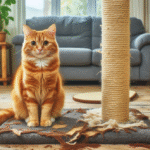Understanding Cat Scratching Behavior
Cat scratching is a natural behavior that serves several key purposes in feline life. Understanding these motivations is essential when considering how to stop cat scratching in 3 days, as it allows pet owners to approach the problem with empathy and effective strategies. One of the primary reasons cats scratch is to mark their territory. Cats have scent glands located in their paws, and by scratching surfaces, they release pheromones that signal to other animals that the area is occupied. This territorial instinct stems from their evolutionary past, where establishing a domain was crucial for survival.
Another essential reason for scratching is the maintenance of their claws. Cats have a natural tendency to shed the outer sheath of their claw to expose a sharper, healthier claw underneath. This instinct not only keeps their claws in top condition but also helps prevent potential injuries. Providing suitable scratching surfaces can satisfy this need and redirect the cat’s energy away from furniture or carpets.
Stretching is an additional, often-overlooked motivation behind cat scratching. Cats enjoy stretching their limbs and back, and engaging in this behavior helps them maintain their overall physical health. Moreover, scratching is a method of exercise that can promote agility and flexibility, important factors for a creature that often pounces on prey in nature.
To effectively manage cat scratching, it is important to recognize and address these inherent behaviors. With the right approach, including the provision of scratching posts and appropriate training techniques, pet owners can learn how to stop cat scratching in 3 days. Understanding the fundamental instincts motivating this activity not only helps in addressing the problem but also deepens the bond between the cat and its owner.
Assessing the Damage: Identifying Scratching Areas

Understanding where your cat scratches the most is a critical first step in learning how to stop cat scratching in 3 days (works every time!). Observing your cat’s behavior diligently can help pinpoint specific locations within your home that are prone to scratching. Cats often scratch as a means of marking their territory, stretching their muscles, or shedding old claw sheaths, making it essential to identify their preferred areas. Begin by taking note of which furniture, curtains, or walls show visible signs of damage such as frayed fabric or scratch marks.
Make a habit of observing your cat’s behavior at different times of the day. Pay close attention to their scratching habits—this can often happen after they wake up, following a meal, or when they are feeling playful. Maintain a journal or log to document these behaviors, noting the time of day and location where the scratching occurs. Over time, this will help you identify patterns or hotspots where scratching is most frequent.
In addition to observing your cat, it may also be helpful to assess the suitability of items around your home. For example, consider the placement of scratching posts or pads. If your cat tends to scratch a particular piece of furniture, think about whether there are suitable alternatives nearby that can redirect their attention. You might also find that certain materials are more attractive to your cat for scratching purposes, prompting additional measures to safeguard those surfaces. By carefully assessing the damage and recognizing these critical areas, you are on your way to effectively addressing this behavior.
Choosing the Right Alternatives: Scratching Posts and Pads

Selecting the right scratching posts and pads is crucial in your endeavor on how to stop cat scratching in 3 days (works every time!). Cats naturally need to scratch to maintain their claws and express their territorial instincts. Providing appropriate alternatives can divert their attention from furniture and carpets to designated scratching items.
Firstly, consider the material of the scratching post or pad. Common options include corrugated cardboard, sisal, and carpet. Sisal is often favored for its durability and texture, as it resembles the feel of outdoor materials that cats naturally scratch. Corrugated cardboard, on the other hand, is not only cost-effective but also appealing to many felines due to its unique texture. Carpet-covered posts are also an option, but ensure that they are sturdy enough to avoid tipping over during use.
Next, size and height play a significant role in the effectiveness of scratching alternatives. Cats instinctively scratch to stretch their bodies, so tall scratching posts are preferable. A good rule of thumb is to choose a scratching post that allows your cat to fully extend its body while scratching. Moreover, wider bases can provide stability and prevent the post from toppling over as your cat scratches aggressively.
Design is another essential factor. Some cats may prefer vertical scratching posts, while others might enjoy horizontal pads. Observing your cat’s behavior can provide insight into which design is more likely to entice them to scratch in the appropriate areas. Additionally, placing the scratching posts and pads in accessible and favored locations—such as near sleeping areas or where they often scratch—can further encourage use.
By thoughtfully selecting scratching posts and pads that cater to your cat’s preferences in materials, sizes, and designs, you can increase the likelihood of redirecting their scratching habits. Implementing these changes will significantly contribute to your goal of how to stop cat scratching in 3 days (works every time!).
Deterring Scratching: Strategies to Protect Furniture
When cats engage in scratching, it can often cause significant damage to furniture and other household items. To effectively address this issue, it’s important to implement a variety of strategies designed to deter your feline friend from their destructive behaviors. By using these methods, you can learn how to stop cat scratching in 3 days (works every time!) and preserve your belongings.
One commonly used method is the application of deterrent sprays that are specifically formulated to repel cats from certain surfaces. These sprays emit scents that are distasteful to felines, encouraging them to avoid the areas treated. When utilizing a deterrent spray, it is imperative to reapply as instructed, especially after cleaning the surface. This will help reinforce the behavior you want to instill in your cat.
Another effective strategy involves the use of double-sided tape. Cats typically dislike the sticky texture on their paws, which can discourage them from scratching furniture. By applying strips of double-sided tape to the areas prone to scratching, you can create an unpleasant experience that will discourage your cat from returning to those surfaces. Be sure to replace the tape regularly, as its effectiveness decreases as it collects dust and debris.
In addition to sprays and tapes, protective covers can be employed to shield your treasured items. These can be furniture covers or specialized scratching pads designed to redirect your cat’s attention. By placing these scratching surfaces near the furniture they typically target, you can provide an alternative that satisfies their natural instinct to scratch while safeguarding your belongings. Ensuring that your cat has access to appropriate scratching posts and surfaces will aid in the process of how to stop cat scratching in 3 days (works every time!) and create a more positive environment for both you and your pet.
Positive Reinforcement: Training Your Cat

Training a cat to stop scratching furniture can be a challenging task, but employing positive reinforcement strategies has proven effective for many pet owners. Positive reinforcement focuses on rewarding desirable behaviors rather than punishing undesirable ones, creating a more harmonious interaction between the pet and owner. This approach not only encourages your cat to use scratching alternatives, such as scratching posts, but also fosters a trusting and affectionate relationship.
To implement positive reinforcement, start by introducing a designated scratching post in a location where your cat frequently scratches. Observe your cat’s behavior closely; when your pet engages with the scratching post instead of your furniture, immediately provide praise, affectionate attention, or a small treat. This incentive will help your cat associate the scratching post with positive outcomes, which is essential in understanding how to stop cat scratching in 3 days.
Consistency is key in the training process. Ensure that every time your cat uses the scratching post, it receives a reward. This reinforces the desired behavior and makes it more likely to occur in the future. It may be helpful to maintain a log of your cat’s scratching habits, noting the interactions with the scratching post versus furniture. This information can guide you in adjusting the placement or type of scratching post if necessary, increasing the likelihood of success.
Consider incorporating additional techniques alongside positive reinforcement to diversify your cat’s experience. For instance, utilizing catnip or toys on the scratching post can make it more appealing. Similarly, gradually transitioning to a different type of scratching surface may keep your cat engaged. With patience and consistency, you can effectively train your cat to make the desired choices about where to scratch. By applying these positive reinforcement techniques, you will be well on your way to discovering how to stop cat scratching in 3 days effectively.
Behavioral Modification Techniques
To effectively address the issue of how to stop cat scratching in 3 days (works every time!), one must explore various behavioral modification techniques. These strategies focus on altering your cat’s natural tendencies through consistent training and environmental adjustments, ultimately leading to long-term success.
One of the primary methods is redirecting your cat’s scratching behavior. Instead of allowing them to scratch furniture, provide designated scratching posts or pads. Choosing the right material is pivotal; cats often prefer sisal or corrugated cardboard. Place these alternatives near the areas they currently scratch. Encourage your cat to use the scratching post by rubbing catnip on it or using toys to create a stimulating environment around it. This method not only diverts their attention but also reinforces a habitual change.
Creating a positive association with designated scratching posts is equally important. This can be achieved through rewarding your cat every time it uses the scratching post instead of furniture. Positive reinforcement, such as treats or gentle praise, will help them understand that using the scratching post leads to enjoyable outcomes. Additionally, consistency is key; ensure that each time you catch your cat scratching something inappropriate, you gently redirect them to the scratching post while simultaneously praising them for using the correct option.
Another effective technique involves temporarily covering surfaces where your cat has been scratching with materials that discourage this behavior. For instance, using double-sided tape or aluminum foil can make unwanted scratching less appealing. Cats usually dislike the texture of these materials, leading them to choose their designated scratching post instead.
In summary, applying these behavioral modification techniques can significantly alter your cat’s scratching habits. With patience, consistency, and positive reinforcement, you can successfully learn how to stop cat scratching in 3 days (works every time!). These efforts not only protect your furniture but also contribute to a happier and healthier relationship with your feline friend.
Creating a Cat-Friendly Environment
Creating a cat-friendly environment is essential for promoting healthy scratching behaviors and significantly reducing undesirable scratching of furniture and carpets. To achieve this, it is crucial to understand a cat’s natural instincts and preferences regarding where and how they like to scratch.
First, consider the layout of your home. Position cat furniture such as scratching posts and pads in key areas where your cat tends to scratch. This might include places near their favorite resting spots or alongside commonly used pathways. Cats often feel the need to scratch after waking up or when they are feeling playful, so placing scratching surfaces in these areas can encourage them to engage with appropriate scratching posts rather than your furniture.
Additionally, the materials used for scratching posts can impact their usage. Cats typically prefer fabrics such as sisal, cardboard, or carpet. Experimenting with different textures can help you determine your cat’s favorites. Ensure that the scratching posts are sturdy and tall enough to allow your cat to stretch fully while scratching, mimicking the natural behavior of scratching trees outdoors.
Furthermore, incorporating vertical space into your home can enhance your cat’s comfort and satisfaction. Cats enjoy climbing and surveying their surroundings from higher vantage points. Cat trees or shelves installed near scratching posts can provide an engaging environment while promoting healthy scratching habits.
Lastly, it is vital to make these appropriate scratching areas appealing. You might consider using catnip or positive reinforcement techniques to encourage your cat to use the designated scratching posts. By understanding how to stop cat scratching in 3 days effectively, you will create an environment that aligns with your cat’s natural behavior, ultimately leading to a more harmonious living space for both you and your pet.
Consistency is Key: Maintaining Your Approach
Establishing effective strategies on how to stop cat scratching in 3 days (works every time!) requires a steadfast commitment to consistency. The implementation of any corrective approach is only as effective as the dedication behind it. Keeping a regular schedule is essential to reinforce the behavior changes you wish to see in your pet. This not only helps in making the cat accustomed to the new routines but also fosters a conducive environment for behavioral correction.
To maintain your consistency, it is advisable to set specific times for the training sessions. Designating a certain time of day to address scratching issues will help build a habit for both you and your cat. During these sessions, ensure that the environment is calm and free from distractions. Training that aligns with a cat’s natural instincts and ensures engagement will prove to be more effective. For example, redirecting your cat to a scratching post immediately after it scratches furniture is a proactive strategy that should be consistently applied.
Monitoring your cat’s behavior is another crucial aspect of maintaining your approach. Keep a journal to record instances of scratching and the methods you employed to redirect or train your cat. This will allow you to identify patterns and track progress over time. If you observe a lack of improvement, you can adjust your methods accordingly. Furthermore, positive reinforcement plays a significant role in encouraging desired behavior. Each time your cat uses the scratching post instead of the furniture, rewarding it with treats or affection will solidify that behavior.
Incorporating these methods with diligence will not only enhance the effectiveness of your training but also ensure a harmonious living environment. Remember, persistence and patience are paramount on your journey to understanding how to stop cat scratching in 3 days (works every time!).
When to Seek Professional Help
Dealing with a cat that scratches can often be a frustrating endeavor. While many instances of scratching can be effectively managed with at-home solutions, there are specific situations where seeking professional help is advisable. Understanding these circumstances can help ensure that both you and your feline companion maintain a harmonious living environment.
One of the primary indicators that professional intervention may be necessary is when a cat’s scratching behavior becomes excessive and results in noticeable damage to furniture or other household items. If you find that your cat is consistently scratching beyond what can be considered normal behavior, it may be time to consult a veterinarian or an animal behaviorist. This could indicate underlying stress, anxiety, or even a medical condition that needs addressing. In some cases, cats will scratch excessively due to an inability to cope with changes in their environment, such as a new pet or alterations in the household routine.
Another critical sign that assistance is warranted is the appearance of injury on the cat itself. If your cat is injuring its skin or causing self-inflicted harm due to its scratching habits, it is essential to seek expert advice immediately. This not only helps prevent further complications but also addresses the scratching behavior more effectively. Additionally, consulting with a professional can provide insights into whether your cat may suffer from other behavioral issues, such as obsessive-compulsive disorder, which could require specialized treatment.
In conclusion, knowing when to seek professional help plays a crucial role in resolving issues related to scratching. Should you notice persistent, damaging, or harmful scratching, do not hesitate to reach out to a qualified expert. They can guide you on the most effective steps to take to ensure your cat’s well-being and restore peace within your home.






